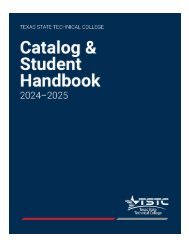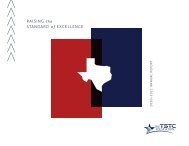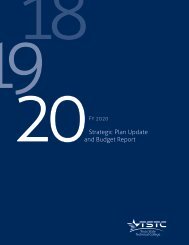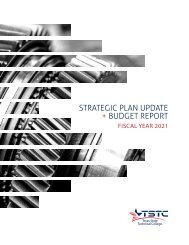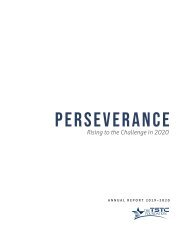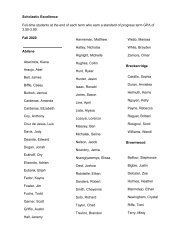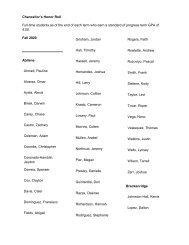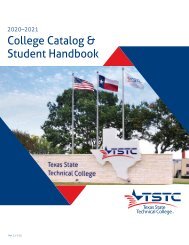Student Handbook and Catalog 2021-22 V2
You also want an ePaper? Increase the reach of your titles
YUMPU automatically turns print PDFs into web optimized ePapers that Google loves.
268 | Essential Elements<br />
Psychomotor Abilities<br />
• Arm-H<strong>and</strong> Steadiness: The ability to keep your h<strong>and</strong> <strong>and</strong><br />
arm steady while moving your arm or while holding your<br />
arm <strong>and</strong> h<strong>and</strong> in one position.<br />
• Control Precision: The ability to quickly <strong>and</strong> repeatedly<br />
adjust the controls of a machine or a vehicle to exact<br />
positions.<br />
• Finger Dexterity: The ability to make precisely coordinated<br />
movements of the fingers of one or both h<strong>and</strong>s to grasp,<br />
manipulate, or assemble very small objects.<br />
• Manual Dexterity: The ability to quickly move your h<strong>and</strong>,<br />
your h<strong>and</strong> together with your arm, or your two h<strong>and</strong>s to<br />
grasp, manipulate, or assemble objects.<br />
• Multi-limb Coordination: The ability to coordinate two or<br />
more limbs (for example, two arms, two legs, or one leg <strong>and</strong><br />
one arm) while sitting, st<strong>and</strong>ing, or lying down. It does not<br />
involve performing the activities while the whole body is in<br />
motion.<br />
• Rate Control: The ability to time your movements or the<br />
movement of a piece of equipment in anticipation of<br />
changes in the speed <strong>and</strong>/or direction of a moving object<br />
or scene.<br />
• Reaction Time: The ability to quickly respond (with the<br />
h<strong>and</strong>, finger, or foot) to a signal (sound, light, picture) when<br />
it appears.<br />
• Response Orientation: The ability to choose quickly<br />
between two or more movements in response to two or<br />
more different signals (lights, sounds, pictures). It includes<br />
the speed with which the correct response is started with<br />
the h<strong>and</strong>, foot, or other body part.<br />
• Speed of Limb Movement: The ability to quickly move the<br />
arms <strong>and</strong> legs.<br />
• Wrist-Finger Speed: The ability to make fast, simple,<br />
repeated movements of the fingers, h<strong>and</strong>s, <strong>and</strong> wrists.<br />
Physical Abilities<br />
• Dynamic Flexibility: The ability to quickly <strong>and</strong> repeatedly<br />
bend, stretch, twist, or reach out with your body, arms, <strong>and</strong>/<br />
or legs.<br />
• Dynamic Strength: The ability to exert muscle force<br />
repeatedly or continuously over time. This involves<br />
muscular endurance <strong>and</strong> resistance to muscle fatigue.<br />
• Explosive Strength: The ability to use short bursts of muscle<br />
force to propel oneself (as in jumping or sprinting), or to<br />
throw an object.<br />
• Extent Flexibility: The ability to bend, stretch, twist, or reach<br />
with your body, arms, <strong>and</strong>/or legs.<br />
• Gross Body Coordination: The ability to coordinate the<br />
movement of your arms, legs, <strong>and</strong> torso together when the<br />
whole body is in motion.<br />
tstc.edu<br />
• Gross Body Equilibrium: The ability to keep or regain your<br />
body balance or stay upright when in an unstable position.<br />
• Stamina: The ability to exert yourself physically over long<br />
periods of time without getting winded or out of breath.<br />
• Static Strength: The ability to exert maximum muscle force<br />
to lift, push, pull, or carry objects.<br />
• Trunk Strength: The ability to use your abdominal <strong>and</strong> lower<br />
back muscles to support part of the body repeatedly or<br />
continuously over time without 'giving out' or fatiguing.<br />
Sensory Abilities<br />
• Auditory Attention: The ability to focus on a single source<br />
of sound in the presence of other distracting sounds.<br />
• Depth Perception: The ability to judge which of several<br />
objects is closer or farther away from you, or to judge the<br />
distance between you <strong>and</strong> an object.<br />
• Far Vision: The ability to see details at a distance.<br />
• Glare Sensitivity: The ability to see objects in the presence<br />
of glare or bright lighting.<br />
• Hearing Sensitivity: The ability to detect or tell the<br />
differences between sounds that vary in pitch <strong>and</strong><br />
loudness.<br />
• Near Vision: The ability to see details at close range (within<br />
a few feet of the observer).<br />
• Night Vision: The ability to see under low light conditions.<br />
• Peripheral Vision: The ability to see objects or movement of<br />
objects to one's side when the eyes are looking ahead.<br />
• Sound Localization: The ability to tell the direction from<br />
which a sound originated.<br />
• Speech Clarity: The ability to speak clearly so others can<br />
underst<strong>and</strong> you.<br />
• Speech Recognition: The ability to identify <strong>and</strong> underst<strong>and</strong><br />
the speech of another person.<br />
• Visual Color Discrimination: The ability to match or detect<br />
differences between colors, including shades of color <strong>and</strong><br />
brightness.<br />
Electrical Power & Controls<br />
Daniel Bateman<br />
dan.bateman@tstc.edu<br />
Cognitive Abilities<br />
• Category Flexibility: The ability to generate or use different<br />
sets of rules for combining or grouping things in different<br />
ways.<br />
• Deductive Reasoning: The ability to apply general rules to<br />
specific problems to produce answers that make sense.<br />
• Fluency of Ideas: The ability to come up with a number of<br />
ideas about a topic (the number of ideas is important, not<br />
their quality, correctness, or creativity).<br />
Texas State Technical College



